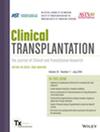Recipient Outcomes After Utilization of Kidneys From Deceased Donors With Diagnosed Glioblastoma Multiforme
Abstract
Background
The exact incidence of donor tumor transmission in patients with glioblastoma multiforme (GBM) is still unknown. These transplants are usually considered as a high-risk endeavor due to fear of potential spread especially with medical intervention leading to breach in blood–brain barrier. This report describes successful outcomes after renal transplantation from two donors with World Health Organization (WHO) Grade IV primary GBM who had undergone surgical excision with ventriculoperitoneal shunt (VPS).
Methods
Between January 2019 and June 2024, case records of organ donors where the primary cause of death was GBM were screened from the departmental database. Renal transplant patients from donors with a histopathological diagnosis GBM WHO Grade IV were included in the study. The follow-up of these recipients was recorded for tumor transmission, delayed graft function, patient and graft survival.
Results
Only kidneys were retrieved from these donors. The donor's kidneys were transplanted to four consented recipients after taking informed consent explaining the risks. During the mean follow-up of 3 years, all four patients were alive with good graft function. Nuclear scan at 3, 6 months, and yearly thereafter showed no abnormal uptake or no evidence of donor-transmitted tumor transmission in any of these patients.
Conclusion
High-grade GBM donors with no evidence of systemic spread may be considered for renal transplantation.

 求助内容:
求助内容: 应助结果提醒方式:
应助结果提醒方式:


